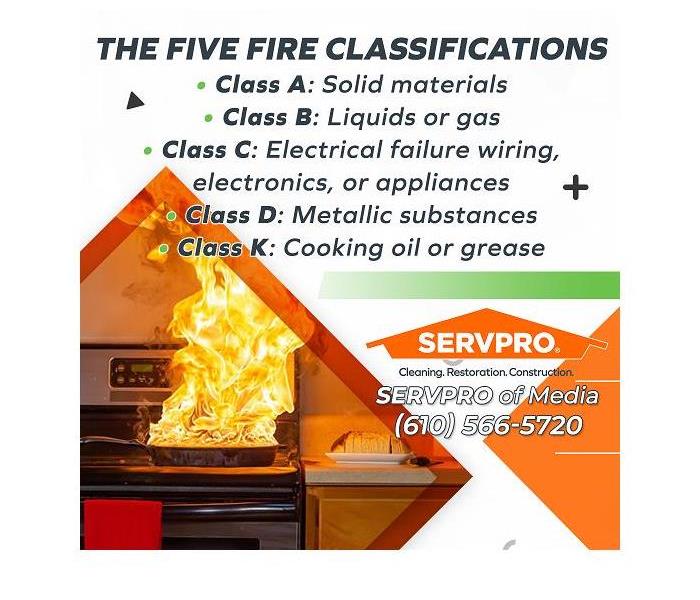Fire Classifications: Important Facts for Preparing for and Protecting against Fire Damage
7/25/2022 (Permalink)
Blog Summary: SERVPRO of Media explains fire classifications and how to recover from the fire damage that different types of fires leave in homes and businesses.
Fire damage protection specialists distinguish between several types or classes of fires. Factors involved in determining the classification of a fire include:
- How fast the fire burns
- How dangerous the fire is
- How a fire is safely and effectively extinguished
The Five Fire Classifications
Fire classification is primarily determined by what caused the fire or what fuels the fire. A thorough knowledge of fire classifications aids homeowners and commercial facilities in identifying fire risks and implementing fire prevention and fire suppression strategies.
Class A: Solid materials
This most common fire type occurs when ordinary combustible materials such as wood, paper products, textiles, garbage, and plastic items catch fire. Because Class A fires are common in homes, businesses, and industries, it is essential to have a general-purpose fire extinguisher on hand, as well as extinguishers for specific conditions.
Recommended fire extinguisher: ABC dry chemical, foam, water, water mist
Class B: Liquids or gas
Class B fires involve petroleum products and other flammable liquids and gases, such as paint, kerosene, diesel, gasoline, and propane.
Recommended fire extinguisher: ABC dry chemical, CO2, clean agent, water mist
Class C: Electrical failure wiring, electronics, or appliances
Electrical fires often occur in facilities relying upon a high usage of electronics and electrical equipment, such as a data center or a mechanized distribution center. Prevention and rapid suppression are crucial. Aging facilities with compromised wiring present a high risk.
Recommended fire extinguisher: ABC dry chemical, CO2, clean agent, water mist
Class D: Metallic substances
Class D fires can be challenging and dangerous to extinguish. Laboratories and chemical plants are vulnerable to Class D fires since flammable items such as titanium, sodium, magnesium, zirconium, and aluminum are often found in these settings. A dry powder suppression solution is recommended to smother any flames. Water can make the situation worse.
Recommended fire extinguisher: Dry powder
Class K: Cooking oil or grease
Class K fires involve flammable cooking liquids. Restaurants and the food service industry are vulnerable since oils, grease, and vegetable and animal fats often fuel Class K fires. Class K fires are dangerous because they can flare up and spread very quickly.
The ‘K’ in Class K does not stand for ‘kitchen.’ A Class K fire extinguisher deploys a fine mist consisting of potassium acetate, potassium carbonate, or potassium citrate. The alkaline mist forms a soapy foam that reduces vapors, steam, and the fire’s risk of re-igniting. Water is not a recommended suppression agent for Class K fires.
Recommended fire extinguisher: Wet chemical, water mist
The Key to Survival: Preparedness
The key to early detection and rapid suppression is preparedness. Preparedness involves three important areas:
- Acquiring the appropriate fire extinguishers for the class of fire for which the home or business is most at risk
- Engaging in regularly scheduled fire safety training
- Maintaining fire safety equipment and keeping it in peak condition
The right equipment, the best training, and proper maintenance can and do save lives. Ask anyone who has been in a house fire or an industrial fire. Minutes matter. Seconds save lives.
Step #1: Acquire the correct fire extinguisher.
Different types of fire extinguishers have been developed to address the five different types of fire. The various types of fire extinguishers best suppress the fire based on what is burning or what caused the fire to ignite in the first place. By having the right extinguisher on hand, the homeowner, employee, or fire safety team at a facility can extinguish the fire safely and quickly.
Step #2: Conduct ongoing fire safety training.
Fire prevention, safe practices during a fire, and fire suppression techniques are three essential components of fire safety training. The fire extinguisher is the first response before the first responders arrive on the scene from the fire department. Every capable person should know the following information.
- Location: Where fire extinguishers are located or stored
- Operation: How to effectively and safely use a fire extinguisher
- Application: Which fire extinguisher is best for the type of fire that has broken out
- Assessment: whether to fight the fire or flee for safety until first responders arrive
When a fire is advanced and is too dangerous to address with minimal equipment and limited manpower, safety is the top priority. It is always best to immediately alert first responders. Fire readiness should include evacuation practice, and routes should be clearly marked. Regular fire safety training keeps everyone informed, increases awareness of technology, and improves skills in using fire suppression equipment.
Step #3: Conduct regular inspections, maintenance, and testing.
Equipment works best when at its best. Replace fire extinguishers that are expired. Local fire regulations often include mandatory building inspections by local fire officials to ensure code compliance in the areas of fire protection systems, occupant capacity, and fire alarm requirements.
A fire damage disaster creates a multi-dimensional damage site involving fire, smoke, soot, water, toxic chemicals and vapors from the combustion process, and chemicals from any fire suppressants deployed in extinguishing the fire. The complex environment requires the services of fire damage restoration professionals who are well-trained, experienced, well-equipped, and confident working in a highly toxic setting. Available 24/7, 356 days a year, including holidays, the SERVPRO team provides a rapid response and a quick cleanup and restoration. This prompt action returns life to normal as soon as possible.
For more information about SERVPRO of Media’s fire damage cleanup services in Broomall, PA, and nearby areas, reach out to the office by phone at (610) 566-5720 or email office@SERVPROmedia.com






 24/7 Emergency Service
24/7 Emergency Service
